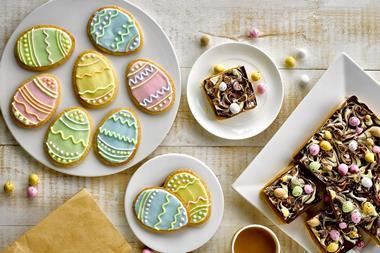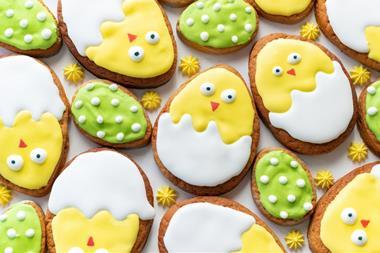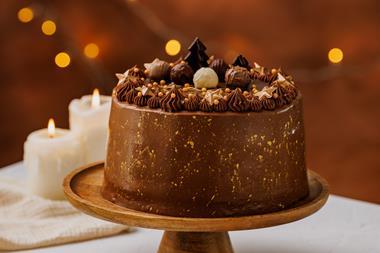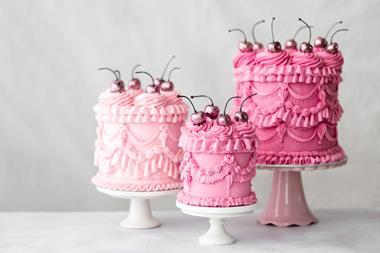Alice Cooke talks to industry experts about how to pull a rabbit out of a hat this Easter by making the most of seasonal trends and flavours
Download a pdf of this report here
With tinsel and turkey a distant memory, bakers are focused on the next big seasonal opportunity.
For many, Easter is characterised by food – from pancakes before Lent to hot cross buns dripping with butter, and chocolate eggs of all sizes. The recent Big Baking Trends Survey from bakery ingredients manufacturer Renshaw has found that most bakers want to bake more occasion and celebration cakes and that, in terms of an annual focus, Easter comes second only to Christmas.
This year Easter will be late in the month, on 17 April. Historically the later the day falls, the earlier shoppers stock up on Easter goods, according to Kantar Worldpanel.
And although retail price deflation took its toll on overall value sales of bakery goods last Easter, Brits bought more bakery products, with volumes up 0.9% year on year {Kantar]. Growth was driven by hot cross buns which, far from being a treat enjoyed only on Good Friday as tradition dictates, have become a year-round bakery staple.
But, in turn, the Easter bakery market is not immune to outside factors such as sugar being firmly in the firing line.
We’re a health-conscious bunch these days, and the war on sugar rumbles steadily on. The press delights in seasonal buzzkill articles, with headlines such as “Is your Easter egg going to kill you slowly and painfully?” and “Chocolate eggs need an HOUR of running and it takes 40 minutes of yoga for hot cross buns”, which appeared in The Daily Mail last March. Sugar is at the forefront of consumers’ minds and shouldn’t be ignored.
Sugar-free biscuits were big business last year, with gingerbread and chia cookies an increasingly popular alternative. London-based sugar-free ‘treat specialist’ Diablo says Easter means big business.
“Sugar-free demand is growing rapidly in the UK,” says Ilanit Kaufman, marketing director at Diablo. “We do cookies and cakes and have recently extended our ranges because of the huge demand. People want the indulgence without the guilt.”
But rather than cut back on the sweet stuff, Barbara Lunnon, category marketing leader for cakes and muffins at CSM Bakery Solutions, says seasonal guilt can be assuaged by following the trend for all things miniature: “Easter is seen as a time of indulgence and treats, and we are not seeing a demand for low-sugar products. Instead, consumers are asking for products that contain chocolate, sweet treats and rich centres – mini variations on a theme. Easter cupcakes decorated with traditional Easter colours and additions can form part of a range and can vary in size – from mini cupcakes to larger sizes – and mini versions of hot cross buns can also work. Mini portions satisfy a need and have a role to play alongside other products.”
Aldi’s pint-sized hot cross buns did brilliantly last year, according to the discounter. This year they come in packs of nine for 99p, and will be available as part of the supermarket’s Easter bakery offering, which will be in stores from 6 April. Also in the range are brioche hot cross buns, which will retail at 99p for a pack of four.
Jon Turonnet, foodservice sales manager at French bakery and patisserie producer Brioche Pasquier, agrees the best things in bakery continue to come in small packages.
“Consumers are continuing to opt for smaller and lighter choices,” he says, adding that quality and indulgence are still key. “The small treat offers a luxurious sweet taste at the end of a meal without the heaviness of a full pudding, or a selection can be served together as a sweet sharing platter.
He suggests that for Easter, a business could offer a choice of mini-patisserie products at afternoon tea and allow customers to choose three from a selection to accompany a hot drink.
At Belgian pastry producer Pidy, those wanting a “quick sweet fix” at Easter can opt for the smaller sweet telline pastry cases. “It is the perfect accompaniment to a hot beverage and just the right amount to satisfy a sweet craving,” says Paul Eason, chef and business development manager at Pidy UK. “They are ready-to-fill with chocolatey fillings and wonderful toppings, but on a smaller scale, ideal for those who may not want to indulge too much.”
Overseas influences are nothing new to bakery, and finding a growing audience in the UK is the Eastern European babka.
France is also making a big impact, according to Turonnet: “Petit-fours, macarons and choux aux fruits make a very pretty Easter offering, with the fresh colours making an attractive spring-like display,” he says.
As for the flavour combinations favoured by consumers, he says caramel and coconut are where it’s at this year: “Patisserie, cakes and biscuits lend themselves to visual and ingredient innovation due to their flexibility for taking on-trend flavours and novel serving suggestions. It seems we still can’t get enough salted caramel or coconut in our desserts, and tropical fruits may see a resurgence in 2017.”
Lunnon at CSM agrees: “In terms of flavours, Easter is still seen as an indulgent season where traditional products and flavours such as currants, citrus and mixed spices are key. Fruit flavours like berries and apricots will be popular in 2017 and indulgent flavours such as caramel, chocolate and fudge will still be in demand.”
She adds that catering for sugar-conscious customers shouldn’t be a reason to avoid that synonymous Easter indulgence – chocolate.
Cadbury Cakes producer and Mr Kipling owner Premier Foods has launched a new range in response to the seasonal opportunity. The occasion cakes market is worth £138m and growing at 5.2% annually, according to the company. In response, it will add a fresh touch to Mr Kipling with Orange & Lemon Slices and Lemon Bakewells. Similarly, Cadbury Cakes will be expanding its whole cakes offering by introducing a Cadbury Mini Egg Easter Joy Cake, filled with a yellow butter cream and topped with popular Cadbury Mini Eggs.
Finsbury Food Group agrees that celebration cakes will be big news this Easter, and is tapping the trend for piñata-style cakes with surprises inside. Richard Hawney, group head of category management and insight at Finsbury, says: “We have produced a number of own-label celebration cakes for Easter that play into the current trend of ‘surprise inside’ and all have a big element of fun to them. The ‘surprise inside’ cakes, which include an Asda Tree Trunk Surprise Cake and Tesco Hidden Yolk Gift cake, are all new to the category and for Easter 2017.”
As Jacqui Passmore, marketing manager UK and Ireland for Dawn Foods says: “Bakers can really cash in on seasonal demand by getting creative with their Easter-themed offerings. It’s all about hopping on to new trends and introducing fresh ideas to put a spring in consumers’ steps as they seek out a treat.”
Babka – an Eastern European tradition
Babka is a traditional spongy, brioche-like Eastern European yeast cake that has become a hit in New York, and is gaining favour in London.
It is traditionally baked for Easter Sunday in Poland, Bulgaria, Macedonia, and Albania, and for the major holidays in Romania. Traditionally it does not have any filling, and is glazed with a vanilla- or chocolate-flavoured icing and decorated with almonds or candied fruit, sometimes with added rum.
Waitrose Magazine tells British Baker that babka is one of its most popular recipes, and Mary Berry even made one on her television show that first aired last spring, Easter Feast.
There are two distinct versions of babka. One is a Polish Christian tradition, baked for Easter in a round, bundt-style shape, with an iced topping. It resembles a grandmother’s skirt, which is why it is called babka, a diminutive of babushka, which is Polish for grandmother.
The second is Jewish babka, which is an enriched dough rolled around a filling of dried fruit and nuts, or cinnamon & chocolate, then halved and twisted around itself into a plait, before being baked in a loaf tin. This is the one that is taking London bakeries in particular by storm.
In west London at Honey and Co bakery, you’ll find krantz cake, a babka filled with dark chocolate and hazelnuts, or white chocolate and tahini.
Meanwhile at north London’s The Good Egg, pastry chef Oded Mizrahi has said he cannot make babka fast enough – his date and pecan version is a best-seller. Also in that neck of the woods, you can find a sourdough babka at Margot Bakery.
Chocolate and plum bakes
From Simon and Helen Pattinson’s Montezuma’s Chocolate Cookbook
For the base
- 170g dark chocolate, chopped
- 14g active dried yeast
- 100ml warm milk
- Large pinch of salt
- 6 tablespoons caster sugar
- 525g plain flour, plus extra for dusting
- 4 large eggs, beaten
- 320g butter, soft, plus extra for greasing
For the filling
- 480ml whole milk
- 4 large egg yolks
- 6 tablespoons sugar
- 3 tablespoons cornflour, sifted
- Pinch of salt
- 200g dark chocolate
- 2½ tablespoons unsalted butter, at room temperature
- 16 plums, pitted and quartered
Method
- Grease tartlet pans with butter. Place chocolate in bain-marie or heatproof bowl over a pan of water that boiled 5 minutes earlier and is now off the heat and cooling. Stir occasionally until smooth.
- Place yeast and milk in a large bowl and beat lightly. Add salt and sugar.
- Transfer to bowl of an electric mixer and, using dough hook attachment at low speed, add flour and eggs and beat for one minute. Once combined, continue mixing until smooth. Add the butter and mix for further three minutes before adding melted chocolate.
- Cover with a clean cloth and leave in a warm place until the dough has doubled in volume (1–2 hours). Flip dough onto a floured surface and knock back the dough to get rid of any unwanted air pockets. You may need to repeat this a few times. Refrigerate for 2–3 hours.
- When cooled, roll out dough to 1cm thick. Cut out rounds and line the buttered pans with the dough.
- To make chocolate filling, bring the milk to the boil in a pan. Whisk yolks together in a bowl with sugar, cornflour and salt, until thick.
- Gradually add milk to the egg and sugar mixture, whisking continuously, at first slowly, and then slightly faster. Put pan over a medium heat. While still whisking vigorously and thoroughly, bring the mixture to the boil. Keep boiling and whisking for 1–2 minutes before removing from the heat.
- Melt the chocolate, as before.
- Whisk the chocolate into the filling. Let it stand for 5 minutes, before whisking in the butter, stirring until the cream is smooth and silky. Refrigerate for 20–30 minutes.
- Preheat the oven to 180°C/gas mark 4. Spoon the pastry cream into the pastries and arrange the plum pieces on top. Cover the tarts with a clean cloth and leave in a warm place for 15 minutes to rise.When the tarts are risen, bake them for 15–20 minutes. Cool before popping them out of the tartlet pans.





























No comments yet